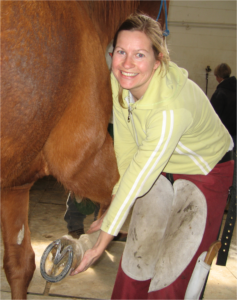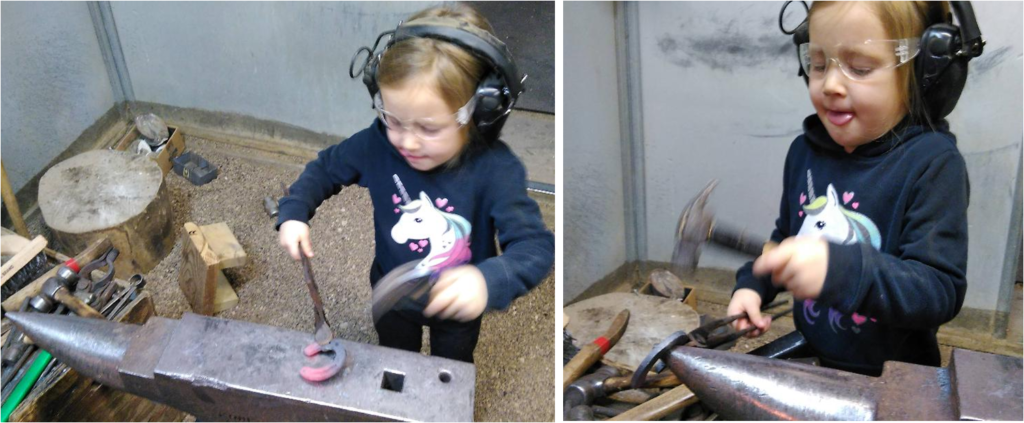Gender is Not a Qualification

Gender is not a prerequisite to be a farrier. The most important character traits are determination, strength and endurance.
In recent years, there have been more and more women entering the farrier profession. There is a misconception that shoeing horses is a “man’s job.” Some may believe this is true because it is a very physically demanding craft. Women shouldn’t be discouraged by this inaccurate assumption. It is very true that being a farrier is hard work. However, one’s ability to be successful depends on their desire and determination; not their gender. Still, the myth unfortunately raises its ugly head. I have heard many young women lament, “I would love to be a farrier. I love horses. I want to work with horses but I’m too small or I’m not strong enough.” I disagree with this wholeheartedly. Some of our best students at Butler Professional Farrier School have been women.
Gender is not a prerequisite to be a farrier. The most important character traits are determination, strength and endurance. Strength can be cultivated over time. People will endure when it gets tough, if they have a desire and determination to do so. Women have often been the most motivated in class. In addition, many of our female students have often shown more concern for horses’ welfare than their fellow male students. Empathetic horsemanship is a key character trait for the ideal farrier.
One time in a class, a male student was trying to shoe a horse. The horse was impatient and moved around a lot. The student reacted to the horse’s movement by losing his patience and the situation escalated quickly. The horse started to kick and fight. Finally, he said, “This horse can’t be shod! He’s not trained! I won’t do it!” In that same class, there was a female student who was a terrific horseman. I knew that she would be able to handle the horse. I asked her if she wanted to give it a try. She jumped right in and went to work. The same horse that was unmanageable a minute ago was now calm. Even though the female student didn’t have an outward appearance of musclebound strength, she had a calming effect and a firm expectation for the horse to stand still. She was willing to stick with it, be patient with the horse, and get the job done.
Simply being female does not automatically make someone a better horseman. It is also true that simply being male doesn’t automatically make a person stronger. I have seen women lose their temper and beat on horses with a rasp. One of the roughest horse handlers I’ve ever seen was a woman. We have had female (as well as male) students that have not shown patience or concern for the horse. Regardless of one’s gender, individual character and horsemanship must be developed to be a successful farrier.
My four-year old daughter will come out to the shop and ask to “help out” with the work. I find jobs for her to do because I want to encourage her desire to work in the shop and around the horses. At her age, it has not occurred to her that her ability might be limited because she is a girl. No one has told her she can’t do it. She believes she can. Whether she continues to show an interest in horses or not, I hope she will always retain the attitude that she isn’t limited by her gender. If she has a desire, I want her to learn that it takes hard work to achieve any goal.
Individuals (male and female) that are interested in farriery should be honest with themselves about the difficult nature of the work. It is not for everyone due to the physical and mental demands required to do the job. Those who want to get into the craft should recognize their own limitations (physical or mental disabilities) and determine for themselves how hard they are willing to work. Gender has no effect on desire and determination, and should never be considered a limitation to being a successful farrier. There are very few obstacles that cannot be overcome to achieve what you want.
Related Posts
-
Ask a dissatisfied horse owner what their biggest frustratio...Oct 11, 2018 / 0 comments
-
The question of whether or not a horse owner should shoe his...Aug 30, 2018 / 0 comments
-
On Saturday (9 June 2018), Justify, trained by Bob Baffert, ...Jun 07, 2018 / 0 comments
Blog Categories
- Anatomy
- Best Business Practices
- Conformation
- Current Events
- Customer Service
- Draft Horse Shoeing
- Equine Soundness
- Essential Anatomy Kit
- Farrier Careers
- Farrier training
- Foal soundness
- Horse Care
- Horse Foot Care
- Horse Owner Tips
- Horsemanship
- Horseshoeing
- Horseshoeing History
- Iron and Forge Work
- Student Spotlight
- Uncategorized
- Veterinary Care
Blog Archives
Contact Us
Butler Professional Horseshoeing School
495 Table Road
Crawford, NE 69339
(800) 728-3826
jacob@dougbutler.com
Subscribe to Our Blog
Get Our Free e-Book!
If you think you want to become a farrier (or know someone who does), this book can help you make that decision. Horse owners will learn the importance of choosing a qualified farrier and how to select the “right” one.
[ Get the e-Book Now! ]
- Follow:

